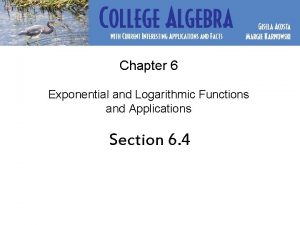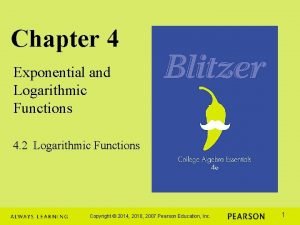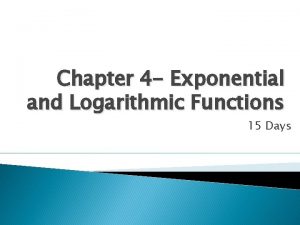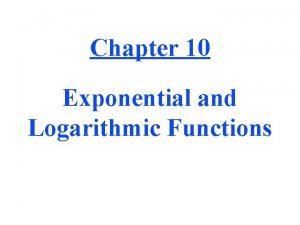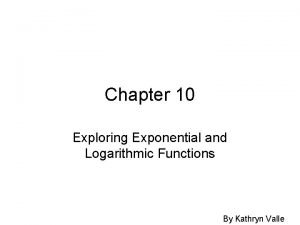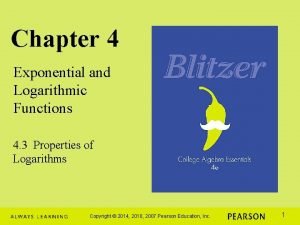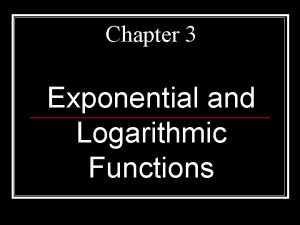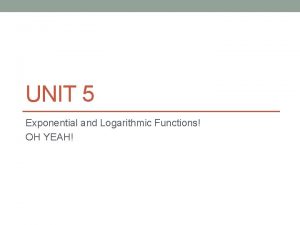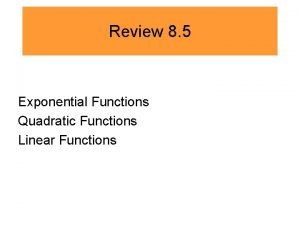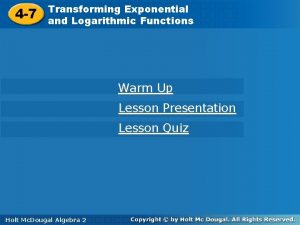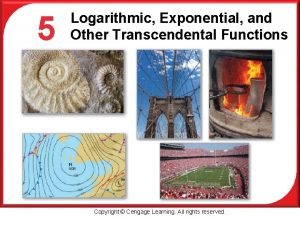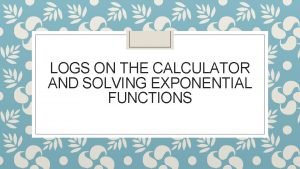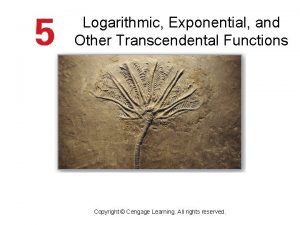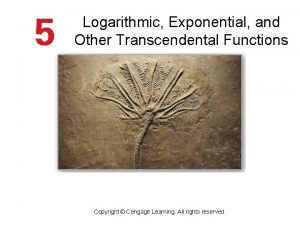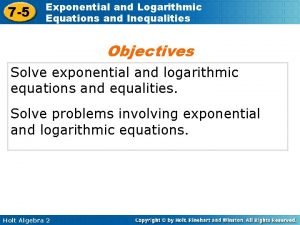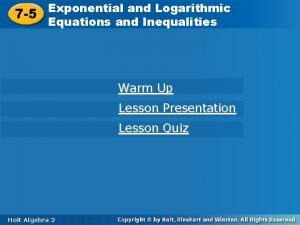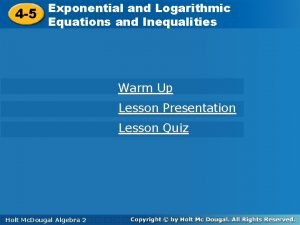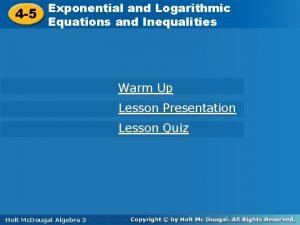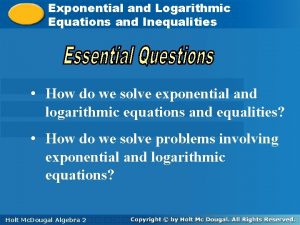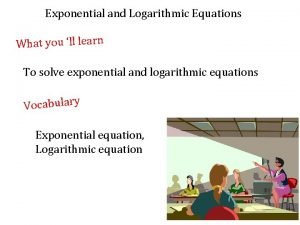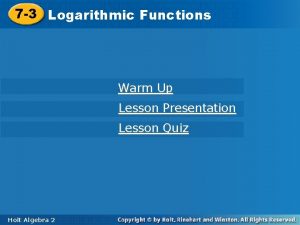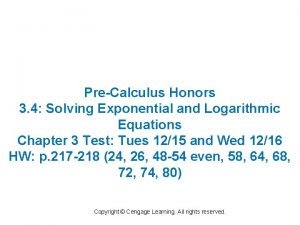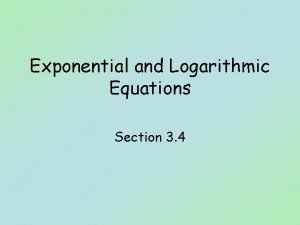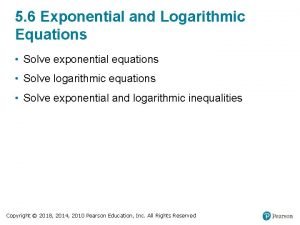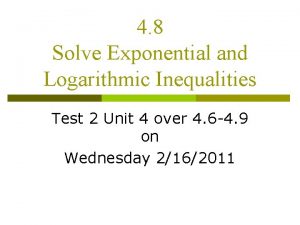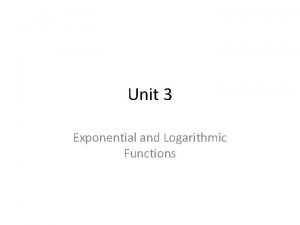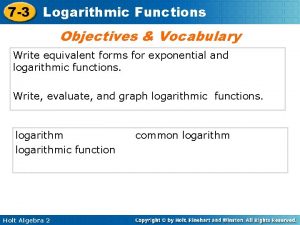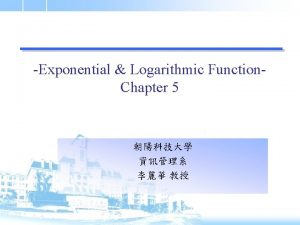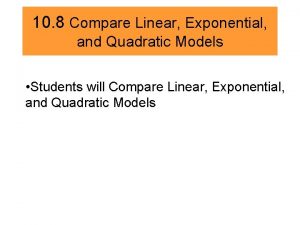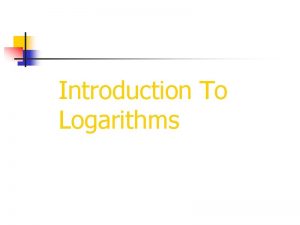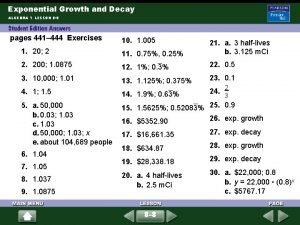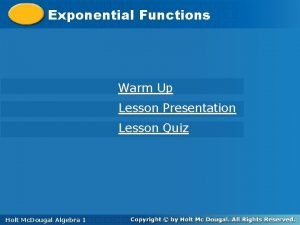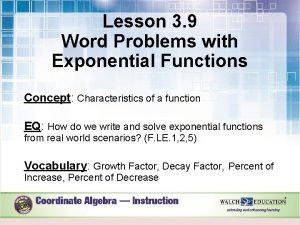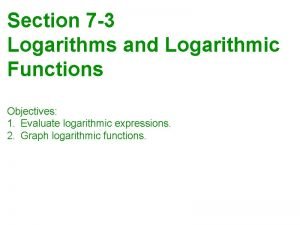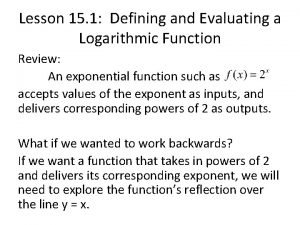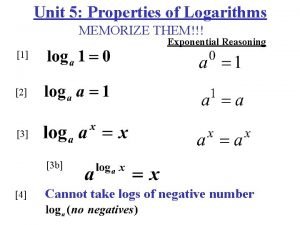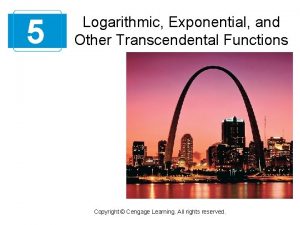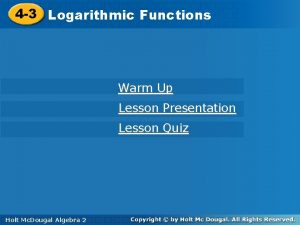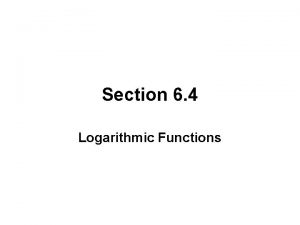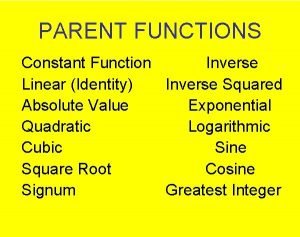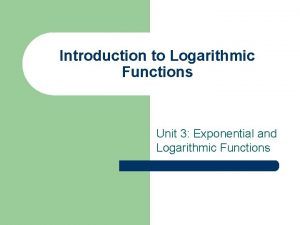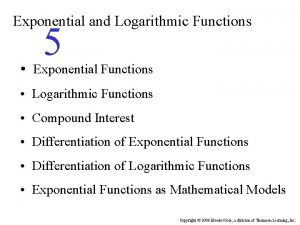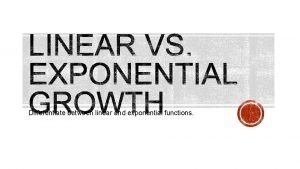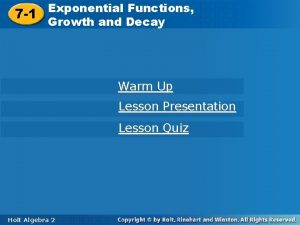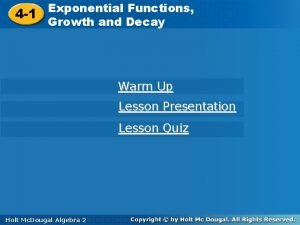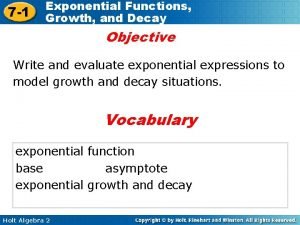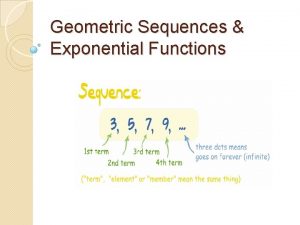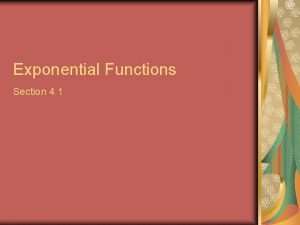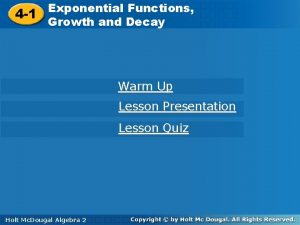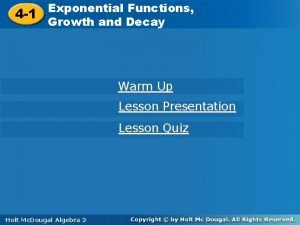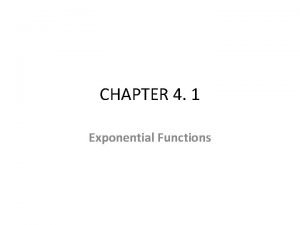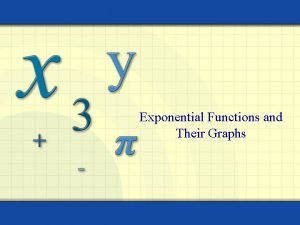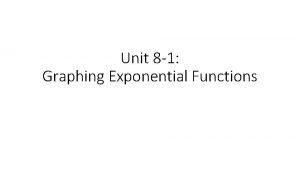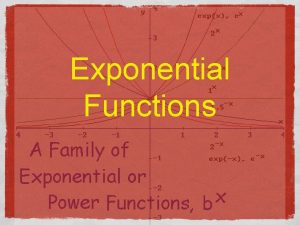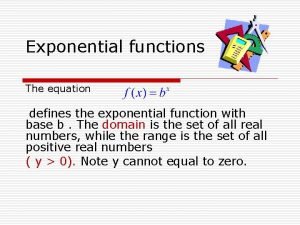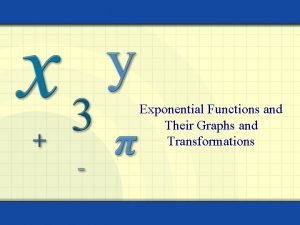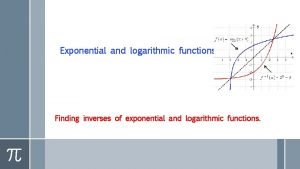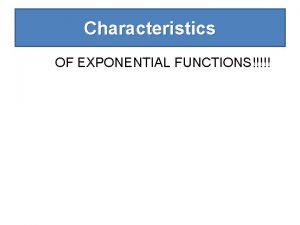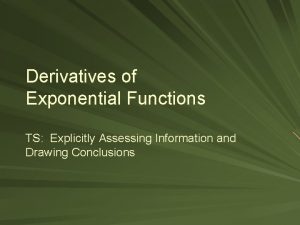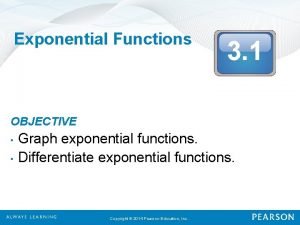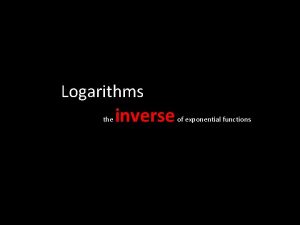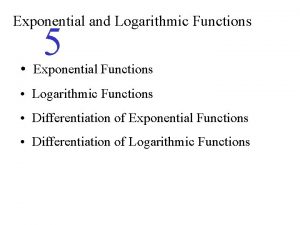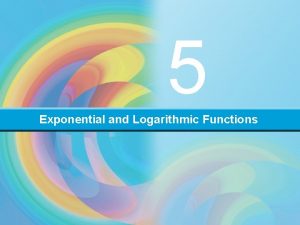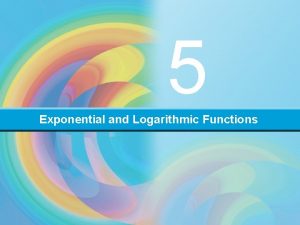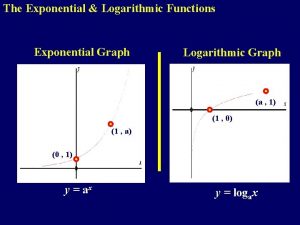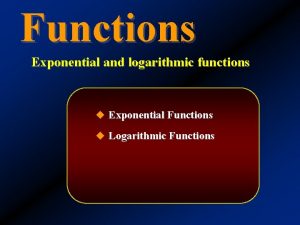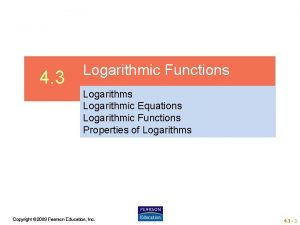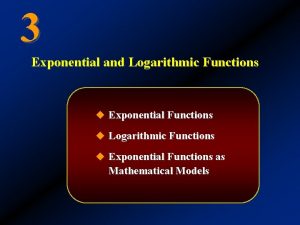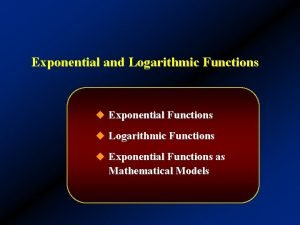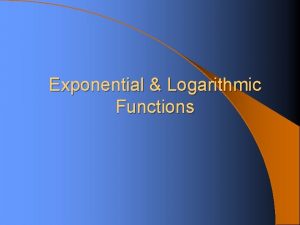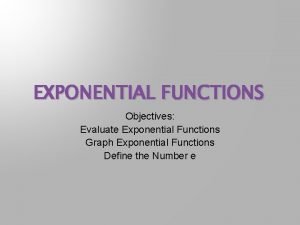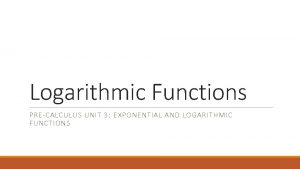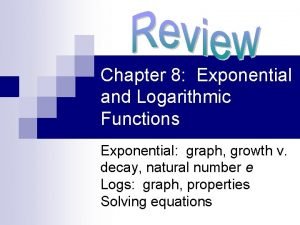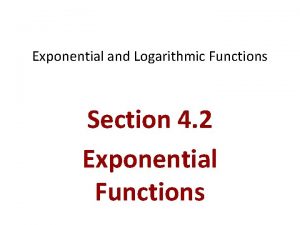Chapter 10 Exponential and Logarithmic Functions Lesson 10
























































































- Slides: 88

Chapter 10 Exponential and Logarithmic Functions

Lesson 10. 1: Exponential Functions

Learning Targets: • I can graph exponential functions. • I can determine if an exponential function is growth or decay. • I can write an exponential function given two points. • I can solve equations involving exponents.

Graphing an exponential function: y = a∙bx standard form of an exponential function a = y-intercept b = base x = exponent (0, a)

Example 1: Graphing Exponential Functions Sketch the graph of y = 4 x and identify its domain and range. Domain: ____ Range: _____

Example 2: Graphing Exponential Functions Sketch the graph of y = 0. 7 x and identify its domain and range. Domain: ____ Range: _____

What type of function is it? Growth Decay

Example 3: Indicate whether each exponential function is growth or decay. Decay Growth Decay

Example 4: Write an exponential function whose graph passes through the given points. (0, -2) and (3, -54) x y = a∙b

Example 5: Write an exponential function whose graph passes through the given points. (0, 7) and (1, 1. 4) x y = a∙b

Example 6: Write an exponential function whose graph passes through the given points. (0, 3) and (-1, 6) x y = a∙b

Example 7: Write an exponential function whose graph passes through the given points. (0, -18) and (-2, -2) x y = a∙b

Remember the Exponent Rules:

Example 8: Simplify expressions. a. b.

Example 8: Simplify expressions. c. d.

Example 9: Solve equations. Step 1: Make the bases the sam Step 2: Set the exponents equa Step 3: Solve.

Example 10: Solve equations.

Example 11: Solve equations.

Home Fun 10 -1 Worksheet

Lesson 10 -2: Logarithmic Functions Objectives: I can…. Ü Convert from logarithmic to exponential form and vice versa. Ü Evaluate logarithmic expressions. Ü Solve logarithmic equations.

Definition of Logarithm: Let b > 0 and b 1. Then n is the logarithm of m to the base b, logb m = n if and only if bn = m written

Check it out! Exponential Form means means Logarithmic Form

Example 1: Convert to exponential form. a. b.

Example 1 (continued) c. d.

Flower Power Root Rule Flower Root Power Root

Example 2: Convert to logarithmic form. a. b.

Example 2 (continued) c. d.

Example 3: Evaluate logarithmic expressions. a.

Example 3 (continued) b.

A couple of intricate ones… c. d.

Think-Pair-Share! a. b.

Example 4: Solve logarithmic equations. a.

Example 4 (continued) b.

Example 4 (still continued!) c.

Example 4 (last one!) d.

Home Fun 10 -2 Worksheet

Click the mouse button or press the Space Bar to display the answers.


Lesson 10 -3: Properties of Logs Learning Targets: Ü I can use the product and quotient properties of logs. Ü I can use the power property of logs. Ü I can solve equations using properties of logs.

Properties Product Property: Example: Quotient Property: Example: Power Property: Example:

Example 1: Solving Equations

Example 2: Solving Equations

Your Turn : Solve each equation. a. b.

Home 10 -3 Worksheet

Click the mouse button or press the Space Bar to display the answers.


Algebra 2 A – Lesson 10 -4 Common Logarithms

Lesson 10 -4: Common Logs Learning Targets: Ü I can find common logarithms. Ü I can solve logarithmic and exponential equations. Ü I can use the Change of Base Formula.

What is a Common Logarithm? This logarithm is used so frequently, that it is programmed into our calculators. We write it as: log m Note that we don’t write the base for a common log.

Example 1: Find Common Logs with a Calculator Use a a) calculator to evaluate each logarithm to four decimal places. log 6 No base labeled, so it must be log 10 (the common log). b) log 0. 35

Change of Base Formula This is a useful formula, because now we can rewrite ANY log as log 10

Example 2: Use the Change of Base Formula Express each log in terms of common logs. Then, approximate its value to four decimal places. a) log 3 16 b) log 2 50

Example 3: Use logs to solve equations where the power is the variable. If necessary, round to four decimal places. a) Solve: x 5 = 62

If necessary, round to four decimal places. x You Try: 3 = 17

If necessary, round to four decimal places. b) Solve: 7 2 x+1 = 11

If necessary, round to four decimal places. 4 x-3 You Try: 6 = 8

Home Fun 10 -4 Worksheet

Algebra 2 B - Chapter 10 Section 5 Natural Logarithms


Lesson 10 -6: Exponential Growth and Decay Story Problems Learning Targets: Ü I can solve problems involving exponential growth (with doubling) Ü I can solve problems involving exponential decay (with half-life)

Doubling Half-life Growth and Decay Problems Growth Doubling Decay Half-life

Example 1: Doubling An experiment begins with 300 bacteria and the population doubles every hour. How many bacteria will there be after: a) 2 hours? b) 10. 5 hours?

Example 2: Decay Problem Suppose a car you bought new for $35, 000 in 2008 depreciates at a rate of 18% per year. a. Write an equation for the car’s value x years after 2008. b. What will the car’s value be after 5 years?

Example 3: Growth A computer engineer is hired for a salary of $70, 400. If she gets a 5% raise each year, after how many years will she be making $100, 000 or more?

Example 4: Half-life Radium-226 has a half-life of 1, 620 years. a) Write an equation for the percent of Radium-226 remaining if there is currently 550 grams after x half-life periods. if there currently 550 grams after x half-life periods. b) If you begin with 4 grams of Radium-226, how much will remain after three half-life periods? c) How many years are equal to three half-life periods of Radium-226?

Practice Story Problem 1 The population of a certain strain of bacteria grows according to the formula y = a(2)x, where x is the time in hours. If there are now 50 bacteria, how many will there be in 2 days?

Practice Story Problem 2 The population N of a certain bacteria grows according to the equation N = 200(2)1. 4 t, where t is the time in hours. a) How many bacteria were there at the beginning of the experiment? b) In how many hours will the number of bacteria reach 100, 000?

Practice Story Problem 3 In 2001, the population of Lagos, Nigeria was about 7, 998, 000. Use the population growth rate of 4. 06% per year a. Estimate the population in 2009. b. In about how many years will the population be over 50, 000?

Practice Story Problem 4 You bought a car for $28, 500 in 2014. It depreciates at 13% each year? a. What is the value of the car in 2018? b. In how many years will the car depreciate to $5000?

Practice Story Problem 5 An isotope of Cesium-137 has a half-life of 30 years. a. If you start with 20 mg of the substance, how many mg will be left after 90 years? b. After 120 years?

Practice Story Problem 6 In 2010, the population of Australia was 17, 800, 000. In 2014, the population is now 22, 000. At what rate is the population growing?

Home practice 10 -6 Worksheet

Algebra 2 B Lesson 10. 5: Natural Logarithms

Learning Targets: I can understand use base e. I can solve base e equations and write equivalent expressions.

Base e • Euler’s number: e • As n increases, approaches the value e ≈ 2. 71828. • “e” is used extensively in finance and business

Base e and Natural Log • The functions y = ex and y = ln x are inverse functions. • A couple interesting properties: • Find the e key and the LN key on your calculators.

Example 1: Write Equivalent Equations Write an equivalent logarithmic or exponential equation. x a) e = 23 b) ln x ≈ 1. 2528

Example 1: Write Equivalent Equations Write an equivalent logarithmic or exponential equation. x c) e = 6 d) ln x = 2. 25

Example 2: Evaluate Natural Logarithms a) ln 21 e b)

Example 3: Solve Equations a)

Example 3: Solve Equations b)

Pert Formula

Example 4: Solve Pert Problems Suppose you deposit $700 into an account paying 6% annual interest, compounded continuously. a) What is the balance after 8 years? b) How long will it take for the balance in your account to reach at least $2000?

ert Your Turn: P Problems Suppose you deposit $1100 into an account paying 5. 5% annual interest, compounded continuously. a) What is the balance after 8 years? b) How long will it take for the balance in your account to reach at least $2000?

Home Practice 10 -5 Worksheet

Click the mouse button or press the Space Bar to display the answers.


Closure Solve. 24 g of a substance has a half-life of 18 years. How much of the substance will remain after 72 years?
 Chapter 6 exponential and logarithmic functions answers
Chapter 6 exponential and logarithmic functions answers Chapter 4 exponential and logarithmic functions
Chapter 4 exponential and logarithmic functions Chapter 4 exponential and logarithmic functions
Chapter 4 exponential and logarithmic functions Chapter 10 exponential and logarithmic functions answers
Chapter 10 exponential and logarithmic functions answers Chapter 5 exponential and logarithmic functions answers
Chapter 5 exponential and logarithmic functions answers Chapter 5 exponential and logarithmic functions
Chapter 5 exponential and logarithmic functions Chapter 4 exponential and logarithmic functions
Chapter 4 exponential and logarithmic functions Chapter 9 exponential and logarithmic functions answer key
Chapter 9 exponential and logarithmic functions answer key Chapter 9 exponential and logarithmic functions answer key
Chapter 9 exponential and logarithmic functions answer key Chapter 5 exponential and logarithmic functions answer key
Chapter 5 exponential and logarithmic functions answer key Chapter 5 exponential and logarithmic functions
Chapter 5 exponential and logarithmic functions Chapter 3 exponential and logarithmic functions
Chapter 3 exponential and logarithmic functions Unit 8 exponential and logarithmic functions
Unit 8 exponential and logarithmic functions Unit 5: exponential and logarithmic functions answers
Unit 5: exponential and logarithmic functions answers Quadratic linear exponential
Quadratic linear exponential Transforming exponential and logarithmic functions
Transforming exponential and logarithmic functions Composite exponential function
Composite exponential function Horizontal line test inverse
Horizontal line test inverse Solving exponential calculator
Solving exponential calculator Inverse functions
Inverse functions Exponential rule integral
Exponential rule integral 7-5 exponential and logarithmic equations
7-5 exponential and logarithmic equations 7-5 practice exponential and logarithmic equations
7-5 practice exponential and logarithmic equations Exponential equations and inequalities
Exponential equations and inequalities Exponential and logarithmic inequalities
Exponential and logarithmic inequalities Exponential and logarithmic equations and inequalities
Exponential and logarithmic equations and inequalities Log to exponential form
Log to exponential form 7-3 logarithms and logarithmic functions answers
7-3 logarithms and logarithmic functions answers 3-4 exponential and logarithmic equations
3-4 exponential and logarithmic equations 3-4 exponential and logarithmic equations
3-4 exponential and logarithmic equations 3-4 exponential and logarithmic equations
3-4 exponential and logarithmic equations Logarithmic curve fitting
Logarithmic curve fitting Log to exponential form
Log to exponential form Solving exponential inequality
Solving exponential inequality Exponential and logarithmic inequalities
Exponential and logarithmic inequalities Exponential and logarithmic inequalities
Exponential and logarithmic inequalities Lesson 7-1 exponential functions growth and decay
Lesson 7-1 exponential functions growth and decay How to write logarithmic form
How to write logarithmic form Logarithmic to exponential form
Logarithmic to exponential form Exponential 5
Exponential 5 Linear quadratic exponential examples
Linear quadratic exponential examples Logarithm to exponential form
Logarithm to exponential form Practice 8-8 exponential growth and decay
Practice 8-8 exponential growth and decay Exponential functions quiz
Exponential functions quiz Lesson 3-1 exponential functions
Lesson 3-1 exponential functions Vertical stretch
Vertical stretch 15.1 defining and evaluating a logarithmic function answers
15.1 defining and evaluating a logarithmic function answers Log(a+b) formula
Log(a+b) formula Integration of inverse trigonometric functions
Integration of inverse trigonometric functions 4-3 logarithmic functions answers
4-3 logarithmic functions answers Logarithmic functions
Logarithmic functions Range of logarithmic functions
Range of logarithmic functions Introduction to logarithmic functions
Introduction to logarithmic functions Exponential rule derivative
Exponential rule derivative Differences between linear and exponential functions
Differences between linear and exponential functions 7-1 exponential functions growth and decay
7-1 exponential functions growth and decay 4-1 exponential functions growth and decay
4-1 exponential functions growth and decay Exponential decay
Exponential decay How to tell if a function is decay or growth
How to tell if a function is decay or growth Explicit and recursive formula
Explicit and recursive formula Vertical translation of an exponential function
Vertical translation of an exponential function 4-1 exponential functions growth and decay
4-1 exponential functions growth and decay 4-1 exponential functions growth and decay
4-1 exponential functions growth and decay 4-1 exponential functions growth and decay
4-1 exponential functions growth and decay Graphing linear and exponential functions
Graphing linear and exponential functions Exponential functions and their graphs
Exponential functions and their graphs Constant ratio exponential functions
Constant ratio exponential functions 7-1 graphing exponential functions
7-1 graphing exponential functions Exponential funtion graph
Exponential funtion graph Exponential function formula
Exponential function formula Exponential function definition
Exponential function definition Transformation of exponential functions
Transformation of exponential functions Inverse log function
Inverse log function Exponential behavior
Exponential behavior Exponential parent function
Exponential parent function Exponential function characteristics
Exponential function characteristics Exponential functions jeopardy
Exponential functions jeopardy Horizontal asymptote in exponential functions
Horizontal asymptote in exponential functions Transformations for exponential functions
Transformations for exponential functions 6-2 exponential functions
6-2 exponential functions Exponential data set examples
Exponential data set examples Multiplier in exponential functions
Multiplier in exponential functions Derivative of exponential function
Derivative of exponential function Exponential functions jeopardy
Exponential functions jeopardy 6-2 exponential functions
6-2 exponential functions Exponential functions in medicine
Exponential functions in medicine 3-1 exponential functions
3-1 exponential functions Horizontal dilation of exponential functions
Horizontal dilation of exponential functions Inverse of exponential functions
Inverse of exponential functions
